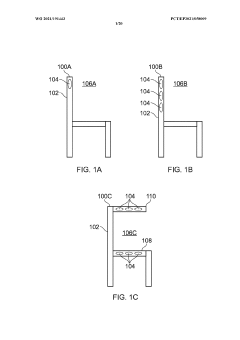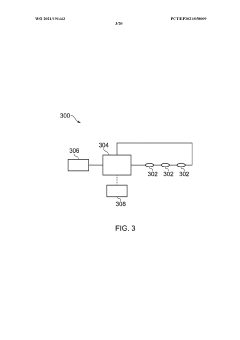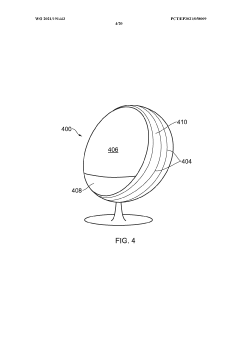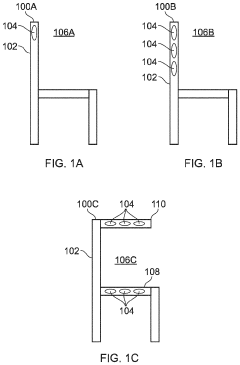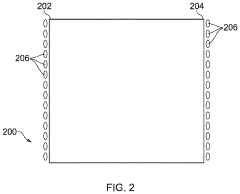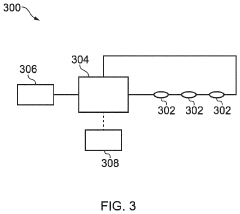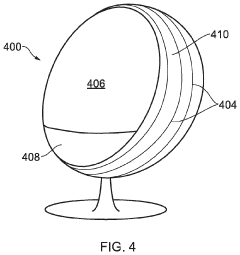Schumann Resonance’s Impact on Biological Rhythm Studies
JUN 24, 20259 MIN READ
Generate Your Research Report Instantly with AI Agent
Patsnap Eureka helps you evaluate technical feasibility & market potential.
Schumann Resonance Background and Research Objectives
The Schumann resonance, discovered by physicist Winfried Otto Schumann in 1952, refers to the natural electromagnetic frequencies in the Earth's atmosphere. These resonances occur in the cavity between the Earth's surface and the ionosphere, with a fundamental frequency of approximately 7.83 Hz and several higher harmonics. Initially considered a purely geophysical phenomenon, the Schumann resonance has gained significant attention in recent years due to its potential impact on biological systems, particularly in the field of chronobiology.
The study of Schumann resonance's influence on biological rhythms has emerged as a fascinating interdisciplinary field, bridging the gap between geophysics, electromagnetic theory, and life sciences. This research area aims to explore the intricate relationship between the Earth's natural electromagnetic environment and the physiological processes of living organisms, including humans, animals, and plants.
The primary objective of investigating Schumann resonance's impact on biological rhythms is to understand how these natural electromagnetic frequencies may influence or synchronize various biological processes. This includes circadian rhythms, sleep-wake cycles, hormone production, and other physiological functions that exhibit periodic patterns. Researchers hypothesize that the Schumann resonance may act as a natural "zeitgeber" or time-giver, helping to regulate and maintain the internal biological clocks of living organisms.
Another crucial aspect of this research is to explore the potential health implications of Schumann resonance fluctuations. As human activities and technological advancements continue to alter the Earth's electromagnetic environment, there is growing concern about the possible effects on biological systems. Understanding the role of Schumann resonance in maintaining biological rhythms could provide valuable insights into the broader impacts of electromagnetic pollution and climate change on human and environmental health.
Furthermore, this research aims to investigate the mechanisms by which living organisms detect and respond to these extremely low-frequency electromagnetic fields. This involves studying the cellular and molecular pathways that may be sensitive to Schumann resonance frequencies, as well as exploring the potential evolutionary adaptations that have allowed organisms to utilize these signals for biological timing and synchronization.
The ultimate goal of this research is to develop a comprehensive understanding of the complex interplay between the Earth's natural electromagnetic environment and biological systems. This knowledge could have far-reaching implications for various fields, including medicine, environmental science, and space exploration. It may lead to novel therapeutic approaches, improved strategies for maintaining health in artificial environments, and a deeper appreciation of the intricate connections between living organisms and their planetary home.
The study of Schumann resonance's influence on biological rhythms has emerged as a fascinating interdisciplinary field, bridging the gap between geophysics, electromagnetic theory, and life sciences. This research area aims to explore the intricate relationship between the Earth's natural electromagnetic environment and the physiological processes of living organisms, including humans, animals, and plants.
The primary objective of investigating Schumann resonance's impact on biological rhythms is to understand how these natural electromagnetic frequencies may influence or synchronize various biological processes. This includes circadian rhythms, sleep-wake cycles, hormone production, and other physiological functions that exhibit periodic patterns. Researchers hypothesize that the Schumann resonance may act as a natural "zeitgeber" or time-giver, helping to regulate and maintain the internal biological clocks of living organisms.
Another crucial aspect of this research is to explore the potential health implications of Schumann resonance fluctuations. As human activities and technological advancements continue to alter the Earth's electromagnetic environment, there is growing concern about the possible effects on biological systems. Understanding the role of Schumann resonance in maintaining biological rhythms could provide valuable insights into the broader impacts of electromagnetic pollution and climate change on human and environmental health.
Furthermore, this research aims to investigate the mechanisms by which living organisms detect and respond to these extremely low-frequency electromagnetic fields. This involves studying the cellular and molecular pathways that may be sensitive to Schumann resonance frequencies, as well as exploring the potential evolutionary adaptations that have allowed organisms to utilize these signals for biological timing and synchronization.
The ultimate goal of this research is to develop a comprehensive understanding of the complex interplay between the Earth's natural electromagnetic environment and biological systems. This knowledge could have far-reaching implications for various fields, including medicine, environmental science, and space exploration. It may lead to novel therapeutic approaches, improved strategies for maintaining health in artificial environments, and a deeper appreciation of the intricate connections between living organisms and their planetary home.
Market Analysis for Biological Rhythm Applications
The market for biological rhythm applications has been experiencing significant growth in recent years, driven by increasing awareness of the importance of circadian rhythms in health and well-being. The global market for circadian rhythm-based products and services is expected to reach substantial value in the coming years, with a compound annual growth rate outpacing many other health-related sectors.
The integration of Schumann Resonance research into biological rhythm studies has opened up new avenues for market expansion. This intersection has sparked interest in developing innovative products that leverage the potential influence of Earth's natural electromagnetic frequencies on human physiology. Wearable devices that monitor and potentially modulate biological rhythms in alignment with Schumann Resonances are gaining traction among health-conscious consumers and those seeking to optimize their performance.
The healthcare sector represents a significant portion of this market, with hospitals and clinics exploring the use of Schumann Resonance-based therapies for various conditions, including sleep disorders, jet lag, and certain mood disorders. The potential for non-invasive, drug-free treatments aligns well with the growing trend towards holistic and personalized medicine.
In the consumer electronics market, there is a rising demand for smart home devices that incorporate Schumann Resonance technology to create environments conducive to better sleep and overall well-being. This includes specialized lighting systems, sound machines, and even electromagnetic field generators designed to mimic or enhance natural Earth frequencies.
The wellness and fitness industry has also begun to incorporate Schumann Resonance concepts into their offerings. High-end spas and retreat centers are marketing treatments and experiences that claim to harmonize guests' biological rhythms with Earth's natural frequencies, appealing to a clientele seeking cutting-edge relaxation and rejuvenation techniques.
Educational and research institutions are another growing market segment, as interest in studying the effects of Schumann Resonances on biological systems increases. This has led to a demand for specialized equipment and software for measuring and analyzing these low-frequency electromagnetic fields and their potential biological impacts.
While the market shows promising growth, it faces challenges such as the need for more robust scientific evidence to support product claims and potential regulatory hurdles. However, as research in this field progresses, it is likely to drive further innovation and market expansion, particularly in areas where traditional approaches to managing biological rhythms have shown limitations.
The integration of Schumann Resonance research into biological rhythm studies has opened up new avenues for market expansion. This intersection has sparked interest in developing innovative products that leverage the potential influence of Earth's natural electromagnetic frequencies on human physiology. Wearable devices that monitor and potentially modulate biological rhythms in alignment with Schumann Resonances are gaining traction among health-conscious consumers and those seeking to optimize their performance.
The healthcare sector represents a significant portion of this market, with hospitals and clinics exploring the use of Schumann Resonance-based therapies for various conditions, including sleep disorders, jet lag, and certain mood disorders. The potential for non-invasive, drug-free treatments aligns well with the growing trend towards holistic and personalized medicine.
In the consumer electronics market, there is a rising demand for smart home devices that incorporate Schumann Resonance technology to create environments conducive to better sleep and overall well-being. This includes specialized lighting systems, sound machines, and even electromagnetic field generators designed to mimic or enhance natural Earth frequencies.
The wellness and fitness industry has also begun to incorporate Schumann Resonance concepts into their offerings. High-end spas and retreat centers are marketing treatments and experiences that claim to harmonize guests' biological rhythms with Earth's natural frequencies, appealing to a clientele seeking cutting-edge relaxation and rejuvenation techniques.
Educational and research institutions are another growing market segment, as interest in studying the effects of Schumann Resonances on biological systems increases. This has led to a demand for specialized equipment and software for measuring and analyzing these low-frequency electromagnetic fields and their potential biological impacts.
While the market shows promising growth, it faces challenges such as the need for more robust scientific evidence to support product claims and potential regulatory hurdles. However, as research in this field progresses, it is likely to drive further innovation and market expansion, particularly in areas where traditional approaches to managing biological rhythms have shown limitations.
Current State and Challenges in Schumann Resonance Detection
The current state of Schumann Resonance detection has seen significant advancements in recent years, yet it still faces several challenges. Modern detection systems have improved sensitivity and accuracy, allowing for more precise measurements of these low-frequency electromagnetic waves. High-resolution spectral analysis techniques have enabled researchers to distinguish between different Schumann Resonance modes and their variations.
Advanced signal processing algorithms have been developed to filter out anthropogenic noise and other electromagnetic interferences, enhancing the quality of Schumann Resonance data. This has led to more reliable long-term monitoring of these resonances, providing valuable insights into global lightning activity and potential correlations with various geophysical phenomena.
However, the detection of Schumann Resonances continues to face several obstacles. One major challenge is the low signal-to-noise ratio, as these resonances are extremely weak compared to other electromagnetic signals in the environment. This necessitates sophisticated noise reduction techniques and highly sensitive equipment, which can be costly and complex to implement.
Another significant hurdle is the impact of local electromagnetic interference, particularly in urban areas. This interference can mask or distort Schumann Resonance signals, making it difficult to obtain accurate measurements. Researchers often need to establish detection stations in remote locations to minimize these effects, which can limit the geographical distribution of measurement points.
The global nature of Schumann Resonances also presents challenges in terms of data integration and interpretation. Variations in local conditions, such as ionospheric properties and ground conductivity, can affect measurements at different locations. Standardizing detection methods and calibrating equipment across various research stations worldwide remains an ongoing challenge.
Furthermore, the relationship between Schumann Resonances and biological rhythms is still not fully understood. While some studies suggest potential influences on human physiology, establishing clear causal links requires more robust experimental designs and long-term data collection. The interdisciplinary nature of this research, spanning atmospheric physics, bioelectromagnetics, and chronobiology, adds complexity to the investigation process.
As research in this field progresses, there is a growing need for more sophisticated modeling techniques to account for the complex interactions between the Earth's surface, ionosphere, and global electromagnetic phenomena. Developing accurate predictive models for Schumann Resonance behavior remains a challenge, particularly in relation to potential biological effects.
Advanced signal processing algorithms have been developed to filter out anthropogenic noise and other electromagnetic interferences, enhancing the quality of Schumann Resonance data. This has led to more reliable long-term monitoring of these resonances, providing valuable insights into global lightning activity and potential correlations with various geophysical phenomena.
However, the detection of Schumann Resonances continues to face several obstacles. One major challenge is the low signal-to-noise ratio, as these resonances are extremely weak compared to other electromagnetic signals in the environment. This necessitates sophisticated noise reduction techniques and highly sensitive equipment, which can be costly and complex to implement.
Another significant hurdle is the impact of local electromagnetic interference, particularly in urban areas. This interference can mask or distort Schumann Resonance signals, making it difficult to obtain accurate measurements. Researchers often need to establish detection stations in remote locations to minimize these effects, which can limit the geographical distribution of measurement points.
The global nature of Schumann Resonances also presents challenges in terms of data integration and interpretation. Variations in local conditions, such as ionospheric properties and ground conductivity, can affect measurements at different locations. Standardizing detection methods and calibrating equipment across various research stations worldwide remains an ongoing challenge.
Furthermore, the relationship between Schumann Resonances and biological rhythms is still not fully understood. While some studies suggest potential influences on human physiology, establishing clear causal links requires more robust experimental designs and long-term data collection. The interdisciplinary nature of this research, spanning atmospheric physics, bioelectromagnetics, and chronobiology, adds complexity to the investigation process.
As research in this field progresses, there is a growing need for more sophisticated modeling techniques to account for the complex interactions between the Earth's surface, ionosphere, and global electromagnetic phenomena. Developing accurate predictive models for Schumann Resonance behavior remains a challenge, particularly in relation to potential biological effects.
Existing Methods for Studying SR-Biorhythm Interactions
01 Schumann resonance and biological rhythms synchronization
Research suggests that Schumann resonances, which are electromagnetic waves in the Earth's atmosphere, may influence biological rhythms in living organisms. Devices and methods have been developed to synchronize human biological rhythms with these natural frequencies, potentially improving health and well-being.- Devices for generating Schumann resonance frequencies: Various devices have been developed to generate Schumann resonance frequencies, which are believed to have beneficial effects on biological rhythms. These devices aim to simulate the natural electromagnetic frequencies of the Earth to promote relaxation, improve sleep, and enhance overall well-being.
- Biological rhythm regulation using Schumann resonance: Research suggests that exposure to Schumann resonance frequencies can help regulate biological rhythms in humans and animals. This includes potential improvements in sleep patterns, circadian rhythms, and overall physiological functioning. Methods and devices have been developed to apply these frequencies for therapeutic purposes.
- Measurement and analysis of Schumann resonance: Advanced techniques and equipment have been developed for measuring and analyzing Schumann resonance frequencies. These tools allow researchers to study the relationship between these electromagnetic waves and biological processes, potentially leading to new insights into human health and environmental interactions.
- Schumann resonance in wearable technology: Wearable devices incorporating Schumann resonance technology have been designed to provide continuous exposure to these beneficial frequencies. These devices aim to improve the wearer's overall health, reduce stress, and enhance cognitive function by aligning the body's rhythms with the Earth's natural frequencies.
- Integration of Schumann resonance in therapeutic environments: Therapeutic environments, such as meditation spaces and wellness centers, are being designed to incorporate Schumann resonance frequencies. These specially designed spaces aim to create an optimal healing environment by simulating the Earth's natural electromagnetic field, potentially enhancing the effectiveness of various therapies and promoting overall well-being.
02 Therapeutic applications of Schumann resonance
Various therapeutic devices and methods utilize Schumann resonance frequencies for potential health benefits. These applications range from stress reduction and sleep improvement to enhancing cognitive function and overall wellness. Some devices combine Schumann resonance with other therapies for synergistic effects.Expand Specific Solutions03 Measurement and detection of Schumann resonance
Advanced technologies have been developed to measure and detect Schumann resonance frequencies with high precision. These systems are used in scientific research, environmental monitoring, and for integrating Schumann resonance data into various applications related to biological rhythms and health.Expand Specific Solutions04 Wearable devices incorporating Schumann resonance
Innovative wearable devices have been designed to generate or simulate Schumann resonance frequencies. These devices aim to provide users with the potential benefits of Schumann resonance exposure in daily life, potentially influencing biological rhythms and overall health.Expand Specific Solutions05 Integration of Schumann resonance in living spaces
Technologies have been developed to incorporate Schumann resonance frequencies into living and working environments. These systems aim to create spaces that are more in tune with natural electromagnetic frequencies, potentially improving occupants' well-being and biological rhythm regulation.Expand Specific Solutions
Key Players in Schumann Resonance and Biorhythm Studies
The study of Schumann Resonance's impact on biological rhythms is in its early stages, with a growing market as interest in electromagnetic influences on health increases. The technology is still emerging, with varying levels of maturity across different research institutions and companies. Organizations like the Academy of Military Medical Sciences, University of California, and University of Bern are at the forefront of academic research. Companies such as Sony Group Corp. and Neuroenhancement Lab LLC are exploring commercial applications. Merck & Co., Inc. and Mitsubishi Tanabe Pharma Corp. are investigating potential pharmaceutical implications. The field is characterized by a mix of established scientific institutions and innovative startups, indicating a competitive landscape with significant potential for growth and breakthrough discoveries.
The Regents of the University of California
Technical Solution: The University of California has been conducting extensive research on the impact of Schumann Resonance on biological rhythms. Their approach involves using advanced electromagnetic field sensors to measure the Schumann Resonance and correlating these measurements with various biological markers in human subjects. They have developed a proprietary algorithm that analyzes the relationship between Schumann Resonance fluctuations and changes in circadian rhythms, sleep patterns, and other physiological processes. This research aims to establish a clear link between geomagnetic activity and human health, potentially leading to new therapeutic interventions.
Strengths: Access to cutting-edge research facilities and a diverse pool of experts. Weaknesses: Complex regulatory environment for human subject research.
University of Bern
Technical Solution: The University of Bern has pioneered a multidisciplinary approach to studying the effects of Schumann Resonance on biological rhythms. Their research team combines expertise from physics, biology, and neuroscience to create a comprehensive model of how electromagnetic fields influence living organisms. They have developed a unique experimental setup that allows for the precise control and manipulation of artificial Schumann Resonance-like fields in laboratory conditions. This setup enables them to study the effects of these fields on various biological processes, including melatonin production, heart rate variability, and brain wave patterns, under controlled conditions.
Strengths: Innovative interdisciplinary approach and state-of-the-art experimental facilities. Weaknesses: Limited sample size due to the complexity of the experimental setup.
Core Innovations in SR-Biological Rhythm Research
A magnetic field exposure system and uses thereof
PatentWO2021191443A1
Innovation
- A magnetic field exposure system generating an amplitude-modulated low frequency magnetic field with a carrier frequency of 360 to 450 Hz and a modulation frequency of 0.5 to 100 Hz, with a field strength of 0.5 to 250 mT, specifically designed to expose organic cells or tissues to improve cell survival, proliferation, reduce stress, and enhance well-being.
A magnetic field exposure system and uses thereof
PatentPendingUS20230372726A1
Innovation
- A magnetic field exposure system generating an amplitude-modulated low frequency magnetic field with a carrier frequency of 360 to 450 Hz and a modulation frequency of 0.5 to 100 Hz, providing a field strength of 0.5 to 250 μT, specifically designed to enhance cell survival, proliferation, reduce stress, and promote tissue regeneration.
Environmental Factors Affecting SR Measurements
The measurement of Schumann Resonances (SR) is significantly influenced by various environmental factors, which can affect the accuracy and reliability of data collected for biological rhythm studies. These factors can be broadly categorized into natural and anthropogenic sources.
Natural environmental factors play a crucial role in SR measurements. Geomagnetic activity, particularly during solar storms, can cause substantial variations in SR parameters. These fluctuations can mask or distort the underlying SR signals, making it challenging to isolate the specific frequencies relevant to biological rhythm studies. Seasonal changes also impact SR measurements, with variations in global lightning activity and ionospheric conditions affecting the resonance patterns throughout the year.
Weather conditions, especially thunderstorms and lightning activity, directly influence SR measurements. The global distribution of thunderstorms, which act as the primary source of SR excitation, varies both spatially and temporally. This variability can lead to fluctuations in SR intensity and frequency, potentially confounding the interpretation of biological rhythm correlations.
Anthropogenic factors also significantly affect SR measurements. The increasing prevalence of electromagnetic pollution from human-made sources, such as power lines, radio transmissions, and electronic devices, can interfere with SR signals. This electromagnetic noise can mask or distort the natural SR frequencies, making it challenging to obtain clean, uncontaminated measurements for biological studies.
Urbanization and industrial activities contribute to local electromagnetic disturbances that can impact SR measurements. The proximity of measurement sites to urban centers or industrial areas can introduce artifacts and noise into the data, necessitating careful site selection and data filtering techniques to ensure the validity of SR measurements for biological rhythm studies.
The Earth's ionosphere, which forms the upper boundary of the SR cavity, is subject to variations caused by solar activity, cosmic rays, and atmospheric composition changes. These ionospheric fluctuations can alter the propagation characteristics of SR waves, affecting the measured frequencies and intensities. Long-term changes in the Earth's magnetic field and climate patterns may also influence SR parameters over extended periods, potentially impacting longitudinal studies of biological rhythms.
To mitigate the impact of these environmental factors, researchers must employ sophisticated measurement techniques and data analysis methods. This includes the use of multiple measurement sites, long-term data collection to account for temporal variations, and advanced signal processing algorithms to filter out environmental noise and isolate the relevant SR signals for biological rhythm studies.
Natural environmental factors play a crucial role in SR measurements. Geomagnetic activity, particularly during solar storms, can cause substantial variations in SR parameters. These fluctuations can mask or distort the underlying SR signals, making it challenging to isolate the specific frequencies relevant to biological rhythm studies. Seasonal changes also impact SR measurements, with variations in global lightning activity and ionospheric conditions affecting the resonance patterns throughout the year.
Weather conditions, especially thunderstorms and lightning activity, directly influence SR measurements. The global distribution of thunderstorms, which act as the primary source of SR excitation, varies both spatially and temporally. This variability can lead to fluctuations in SR intensity and frequency, potentially confounding the interpretation of biological rhythm correlations.
Anthropogenic factors also significantly affect SR measurements. The increasing prevalence of electromagnetic pollution from human-made sources, such as power lines, radio transmissions, and electronic devices, can interfere with SR signals. This electromagnetic noise can mask or distort the natural SR frequencies, making it challenging to obtain clean, uncontaminated measurements for biological studies.
Urbanization and industrial activities contribute to local electromagnetic disturbances that can impact SR measurements. The proximity of measurement sites to urban centers or industrial areas can introduce artifacts and noise into the data, necessitating careful site selection and data filtering techniques to ensure the validity of SR measurements for biological rhythm studies.
The Earth's ionosphere, which forms the upper boundary of the SR cavity, is subject to variations caused by solar activity, cosmic rays, and atmospheric composition changes. These ionospheric fluctuations can alter the propagation characteristics of SR waves, affecting the measured frequencies and intensities. Long-term changes in the Earth's magnetic field and climate patterns may also influence SR parameters over extended periods, potentially impacting longitudinal studies of biological rhythms.
To mitigate the impact of these environmental factors, researchers must employ sophisticated measurement techniques and data analysis methods. This includes the use of multiple measurement sites, long-term data collection to account for temporal variations, and advanced signal processing algorithms to filter out environmental noise and isolate the relevant SR signals for biological rhythm studies.
Ethical Considerations in Human Biorhythm Research
The ethical considerations in human biorhythm research related to Schumann Resonance's impact on biological rhythms are multifaceted and require careful attention. One primary concern is the potential for unintended consequences on participants' health and well-being. As Schumann Resonance frequencies are naturally occurring electromagnetic waves, altering or manipulating these frequencies in research settings could potentially disrupt normal biological processes.
Informed consent is a crucial ethical requirement in such studies. Participants must be fully aware of the potential risks and benefits associated with exposure to modified Schumann Resonance frequencies. This includes providing clear information about the nature of the research, its objectives, and any possible short-term or long-term effects on their circadian rhythms or overall health.
Privacy and data protection are also significant ethical considerations. Research involving biological rhythms often requires continuous monitoring of participants' physiological data. Ensuring the confidentiality and security of this sensitive information is paramount. Researchers must implement robust data protection measures and clearly communicate to participants how their data will be used, stored, and potentially shared.
The principle of non-maleficence is particularly relevant in this field. Researchers must prioritize participant safety and well-being above scientific curiosity. This may involve implementing strict protocols for monitoring participants' health during the study and having clear criteria for stopping the research if adverse effects are observed.
Equity in participant selection is another important ethical consideration. Researchers should strive for diverse representation in their study populations to ensure that findings are generalizable and that potential benefits or risks are not disproportionately distributed among certain demographic groups.
Long-term follow-up studies may be necessary to assess any delayed effects of exposure to modified Schumann Resonance frequencies. This raises ethical questions about the researchers' ongoing responsibilities to participants beyond the initial study period.
The potential for dual use of research findings must also be considered. While the primary intent may be to understand and potentially benefit human health, there is a risk that knowledge gained could be misused for non-therapeutic purposes or even as a form of manipulation.
Lastly, transparency in reporting research methods and results is crucial for maintaining ethical standards and public trust. This includes publishing both positive and negative findings to contribute to the overall body of knowledge in the field of biorhythm research.
Informed consent is a crucial ethical requirement in such studies. Participants must be fully aware of the potential risks and benefits associated with exposure to modified Schumann Resonance frequencies. This includes providing clear information about the nature of the research, its objectives, and any possible short-term or long-term effects on their circadian rhythms or overall health.
Privacy and data protection are also significant ethical considerations. Research involving biological rhythms often requires continuous monitoring of participants' physiological data. Ensuring the confidentiality and security of this sensitive information is paramount. Researchers must implement robust data protection measures and clearly communicate to participants how their data will be used, stored, and potentially shared.
The principle of non-maleficence is particularly relevant in this field. Researchers must prioritize participant safety and well-being above scientific curiosity. This may involve implementing strict protocols for monitoring participants' health during the study and having clear criteria for stopping the research if adverse effects are observed.
Equity in participant selection is another important ethical consideration. Researchers should strive for diverse representation in their study populations to ensure that findings are generalizable and that potential benefits or risks are not disproportionately distributed among certain demographic groups.
Long-term follow-up studies may be necessary to assess any delayed effects of exposure to modified Schumann Resonance frequencies. This raises ethical questions about the researchers' ongoing responsibilities to participants beyond the initial study period.
The potential for dual use of research findings must also be considered. While the primary intent may be to understand and potentially benefit human health, there is a risk that knowledge gained could be misused for non-therapeutic purposes or even as a form of manipulation.
Lastly, transparency in reporting research methods and results is crucial for maintaining ethical standards and public trust. This includes publishing both positive and negative findings to contribute to the overall body of knowledge in the field of biorhythm research.
Unlock deeper insights with Patsnap Eureka Quick Research — get a full tech report to explore trends and direct your research. Try now!
Generate Your Research Report Instantly with AI Agent
Supercharge your innovation with Patsnap Eureka AI Agent Platform!
